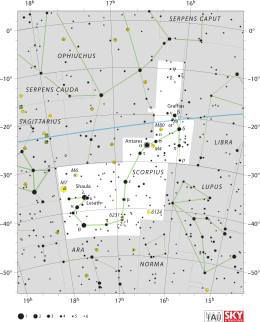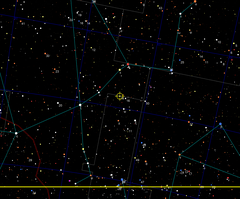18 Scorpii
18 Scorpii is a solitary star located at a distance of some 45.3 light-years (13.9 parsecs) from Earth at the northern edge of the Scorpius constellation. It has an apparent visual magnitude of 5.5,[2] which is bright enough to be seen with the naked eye outside of urban areas.
 | |
| Observation data Epoch J2000.0 Equinox J2000.0 | |
|---|---|
| Constellation | Scorpius |
| Right ascension | 16h 15m 37.26946s[1] |
| Declination | –08° 22′ 09.9870″[1] |
| Apparent magnitude (V) | 5.503[2] |
| Characteristics | |
| Spectral type | G2 Va |
| U−B color index | +0.18[3] |
| B−V color index | +0.64[3] |
| Variable type | Sun-like[4] |
| Astrometry | |
| Radial velocity (Rv) | +11.6[2] km/s |
| Proper motion (μ) | RA: 230.77[1] mas/yr Dec.: -495.53[1] mas/yr |
| Parallax (π) | 71.94 ± 0.37[1] mas |
| Distance | 45.3 ± 0.2 ly (13.90 ± 0.07 pc) |
| Absolute magnitude (MV) | 4.77[2] |
| Details | |
| Mass | 1.02 ± 0.03[5] M☉ |
| Radius | 1.010 ± 0.009[5] R☉ |
| Luminosity | 1.058 ± 0.028[6] L☉ |
| Surface gravity (log g) | 4.45[7] cgs |
| Temperature | 5,433 ± 69[6] K |
| Metallicity [Fe/H] | 0.04[7] dex |
| Rotation | 22.7 ± 0.5[8] |
| Age | 2.9±0.5[9] Gyr |
| Other designations | |
| Database references | |
| SIMBAD | data |
| Exoplanet Archive | data |
18 Scorpii has some physical properties in common with the Sun, a G-type star. Cayrel de Strobel (1996) included it in her review of the stars most similar to the Sun,[10] and Porto de Mello & da Silva (1997) identified it as a younger solar twin.[11][12] Some scientists therefore believe the prospects for life in its vicinity are good. However, no planet has yet been discovered orbiting this star.
Characteristics

18 Scorpii is a main sequence star of spectral and luminosity type G2 Va,[12] with the luminosity class of 'V' indicating it is generating energy through the nuclear fusion of hydrogen in its core region. Sousa et al. (2008) found its metallicity to be about 1.1 times that of the Sun, which means the abundance of elements other than hydrogen or helium is 10% greater.[7][13] The radius of this star, as measured using interferometry by Bazot et al. (2011), is 101% the radius of the Sun. When combined with the results of asteroseismology measurements, this allows the mass of the star to be estimated as 102% of the Sun's mass.[5] This star is radiating 106% of the Sun's luminosity from its outer atmosphere at an effective temperature of 5,433 K.[6] It is this heat that gives the star the yellow-hued glow of a G-type star.[14]
According to Lockwood (2002), it has a temporal photometric behavior very similar to the Sun.[15] Its brightness variation over its entire activity cycle is 0.09%, about the same as the Sun's brightness variations during recent solar cycles.[16] Using the technique of Zeeman-Doppler imaging, Petit et al. (2008) have detected its surface magnetic field, showing that its intensity and geometry are very similar to the large-scale solar magnetic field.[17] The estimated period for the activity cycle of 18 Scorpii is about seven years,[4] which is significantly shorter than the Sun's, and its overall chromospheric activity level is noticeably higher.[16][18] Like the Sun, it has a hot corona with a temperature in the range of 1.5–2 MK and an X-ray luminosity of 8 ± 1.5 ergs s−1.[8]
Though 18 Scorpii is only slightly more metal-rich overall than the Sun, its lithium abundance is about three times as high; for this reason, Meléndez & Ramírez (2007) have suggested that 18 Scorpii be called a "quasi solar twin", reserving the term solar twin for stars (such as HIP 56948) that match the Sun, within the observational errors, for all parameters.[19]
18 Scorpii is a young star at 2.9 Gyr (2.9 Billion years old). 18 Scorpii has not yet entered its stable burning stage. The Sun at 4.7 Gyr is at its most stable stage. Due to 18 Scorpii age, it is at the edge of range for a solar twin, and is more of a Solar analog.[20]
18 Scorpii was identified in September 2003 by astrobiologist Margaret Turnbull from the University of Arizona in Tucson as one of the most promising nearby candidates for hosting life, based on her analysis of the HabCat list of stars. This is a solitary star and, as of 2005, radial velocity measurements have not yet revealed the presence of planets orbiting it.[21] Nor does this star display the level of excess infrared emission that would otherwise suggest the presence of unconsolidated circumstellar matter, such as a debris disk.[22]
18 Scorpii was thought to be 5.0 billion years old in the past, new measurements in 2013 found 18 Scorpii to be younger at 2.9 billion years old.[23]
References
- van Leeuwen, F. (2007). "Validation of the new Hipparcos reduction". Astronomy and Astrophysics. 474 (2): 653–664. arXiv:0708.1752. Bibcode:2007A&A...474..653V. doi:10.1051/0004-6361:20078357.
- Nordström, B.; et al. (2004). "The Geneva-Copenhagen survey of the Solar neighbourhood. Ages, metallicities, and kinematic properties of ˜14 000 F and G dwarfs". Astronomy and Astrophysics. 418 (3): 989–1019. arXiv:astro-ph/0405198. Bibcode:2004A&A...418..989N. doi:10.1051/0004-6361:20035959.
- "18 Sco -- Variable Star", SIMBAD, Centre de Données astronomiques de Strasbourg, retrieved 2011-10-13 The ubv information is per Compilation of Eggen's UBV data, transformed to UBV (unpublished) 1986. See the Measurements section.
- Hall, Jeffrey C.; et al. (July 2009). "The Activity and Variability of the Sun and Sun-Like Stars. II. Contemporaneous Photometry and Spectroscopy of Bright Solar Analogs". The Astronomical Journal. 138 (1): 312–322. Bibcode:2009AJ....138..312H. CiteSeerX 10.1.1.216.9004. doi:10.1088/0004-6256/138/1/312.
- Bazot, M.; et al. (February 2011). "The radius and mass of the close solar twin 18 Scorpii derived from asteroseismology and interferometry". Astronomy and Astrophysics. 526 (526): L4. arXiv:1209.0217. Bibcode:2011A&A...526L...4B. doi:10.1051/0004-6361/201015679.
- Boyajian, Tabetha S.; et al. (February 2012). "Stellar Diameters and Temperatures. I. Main-sequence A, F, and G Stars". The Astrophysical Journal. 746 (1): 101. arXiv:1112.3316. Bibcode:2012ApJ...746..101B. doi:10.1088/0004-637X/746/1/101.. See Table 10.
- Sousa, S. G.; et al. (August 2008). "Spectroscopic parameters for 451 stars in the HARPS GTO planet search program. Stellar [Fe/H] and the frequency of exo-Neptunes". Astronomy and Astrophysics. 487 (1): 373–381. arXiv:0805.4826. Bibcode:2008A&A...487..373S. doi:10.1051/0004-6361:200809698.
- Coughlin, Jared; et al. (January 2010). "The Night Time Sun: X-Ray Observations of the Solar Twin 18 Scorpii". Bulletin of the American Astronomical Society. 42: 333. Bibcode:2010AAS...21542417C.
- NASA, Identification of oldest solar twin may help locate rocky exoplanets
- Cayrel de Strobel, G. (1996). "Stars Resembling the Sun". The Astronomy and Astrophysics Review. 7 (3): 243–288. Bibcode:1996A&ARv...7..243C. doi:10.1007/s001590050006.
- ESO, The life cycle of a Sun-like star (annotated), from European Southern Observatory, 28 August 2013
- Porto de Mello, G. F.; da Silva, L. (1997). "HR 6060: The Closest Ever Solar Twin?". The Astrophysical Journal. 482 (2): L89–L92. Bibcode:1997ApJ...482L..89P. doi:10.1086/310693.
- A metallicity of [Fe/H] = 1.04 dex indicates that the star has 100.04 = 1.096, or 110% of the abundance of elements heavier than helium, compared to the Sun.
- "The Colour of Stars", Australia Telescope, Outreach and Education, Commonwealth Scientific and Industrial Research Organisation, December 21, 2004, archived from the original on February 22, 2012, retrieved 2012-01-16
- Lockwood, G. W.; et al. (May 2002). "Gauging the Sun: Comparative photometric and magnetic activity measurements of sunlike stars, 1984-2001" (PDF). Bulletin of the American Astronomical Society. 34: 651. Bibcode:2002AAS...200.0709L. Archived from the original (PDF) on 2006-09-05.
- Hall, J. C.; Lockwood, G. W. (2007). "The Sun-Like Activity of the Solar Twin 18 Scorpii". The Astronomical Journal. 133 (5): 2206–2208. arXiv:astro-ph/0703450. Bibcode:2007AJ....133.2206H. doi:10.1086/513195.
- Petit, P.; et al. (2008). "Toroidal versus poloidal magnetic fields in Sun-like stars: a rotation threshold". Monthly Notices of the Royal Astronomical Society. 388 (1): 80. arXiv:0804.1290. Bibcode:2008MNRAS.388...80P. doi:10.1111/j.1365-2966.2008.13411.x.
- Hall, Jeffrey C.; Lockwood, G. W. (2000). "Evidence of a Pronounced Activity Cycle in the Solar Twin 18 Scorpii". The Astrophysical Journal. 545 (2): L43–L45. Bibcode:2000ApJ...545L..43H. doi:10.1086/317331.
- Meléndez, J.; Ramírez, I. (2007). "HIP 56948: A Solar Twin with a Low Lithium Abundance". The Astrophysical Journal. 669 (2): L89–L92. arXiv:0709.4290. Bibcode:2007ApJ...669L..89M. doi:10.1086/523942.
- King, Jeremy R; Boesgaard, Ann M; Schuler, Simon C (2005). "Keck/HIRES Spectroscopy of Four Candidate Solar Twins". The Astronomical Journal. 130 (5): 2318–2325. arXiv:astro-ph/0508004. Bibcode:2005AJ....130.2318K. doi:10.1086/452640.
- Marcy, Geoffrey W.; et al. (2005). "Five New Extrasolar Planets". The Astrophysical Journal. 619 (1): 570–584. Bibcode:2005ApJ...619..570M. CiteSeerX 10.1.1.516.6667. doi:10.1086/426384.
- Lawler, S. M.; et al. (2009). "Explorations Beyond the Snow Line: Spitzer/IRS Spectra of Debris Disks Around Solar-type Stars". The Astrophysical Journal. 705 (1): 89–111. arXiv:0909.0058. Bibcode:2009ApJ...705...89L. doi:10.1088/0004-637X/705/1/89.
- NASA NEWS, Identification of oldest solar twin may help locate rocky exoplanets, August 29, 2013
External links
- Kaler, James B. "18 Scorpii". Stars. University of Illinois. Retrieved 2012-03-06.
- NASA article on 18 Scorpii
- 18 Scorpii entry in the stellar database
- Astronomers Measure Sun-Like Brightness Changes of the Solar Twin, 18 Scorpii
- Nissen, P. E. (July 2015). "High-precision abundances of elements in solar twin stars. Trends with stellar age and elemental condensation temperature". Astronomy & Astrophysics. 579 (52): 15. arXiv:1504.07598. Bibcode:2015A&A...579A..52N. doi:10.1051/0004-6361/201526269. A52.
.jpg)